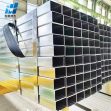Popular Types of Glass Curtain Wall in the Market
Glass Curtain Wall
Glass curtain wall is generally used for a lightweight aluminum-framed facade made of glass or metal panels in a building. But the glazing system doesn’t support the weight of a roof or floor. Instead, gravity loads and wind resistance transfer from the surface to the building’s floor line. Each glazing system requires careful integration with other adjacent structural elements such as wall claddings, roofs, and wall details. Curtain wall systems are available from standard prefabricated systems to specialized custom wall units in the current market. Increased costs often come with additional customization and larger sizing. In the modern times, glass curtain walls are not exclusive to commercial applications. They also provide viable glazing solutions for residences as well.

Interior and Exterior Glass Curtain Wall:
Unitized and modular glass curtain wall systems work as both interior and exterior glazing applications. Each offers various advantages and disadvantages for curtain wall buildings in most cases. Specifically speaking, interior glazed systems allow for glass or opaque panel installation into the curtain wall openings from the interior of the building, which typically require specific design per their application. And exterior glazing systems work well for low rise construction projects that allow for an easy access to the exterior building. Larger high-rise construction projects may require interior glazing. This is due to the logistics of accessing and replacing multiple stories of glass. These systems often require scaffolding or booms to access the exterior of the curtain wall when repairing or replacing components. In certain cases, curtain wall systems can be glazed from either the interior or exterior of the building.
Popular Types of Glass Curtain Wall System:
Pressure-equalized rain screen systems are the best choice if you need a system to resist air and water infiltration. A gasket surrounds the face of the glass and creates a pressure equalized chamber that forms an airtight barrier. The outside face of the glass and accompanying exterior glazing materials with the aluminum framing create a rain screen and shed water away. These systems also do a fair job of transferring wind loads.
Water-managed systems incorporate drains and weeps. This type of glass curtain wall system is mostly designed to resist water infiltration, but it makes no effort to create an air barrier or “zone-glaze”. This means that a larger amount of water is forced into the system, which should keep weeping away. Since no air barrier exists, the pressure differential between the glazing pocket and the interior may be strong enough to force water vertically higher than interior gaskets. This results in leaks.
Face-sealed systems require continuous and perfect seals between each glass unit between curtain wall structures in applications. The long-term durability of these seals is minimal. Patching these systems may require glazing tape.
Tel: +86 18202256900 Email: steel@fwssteel.com










